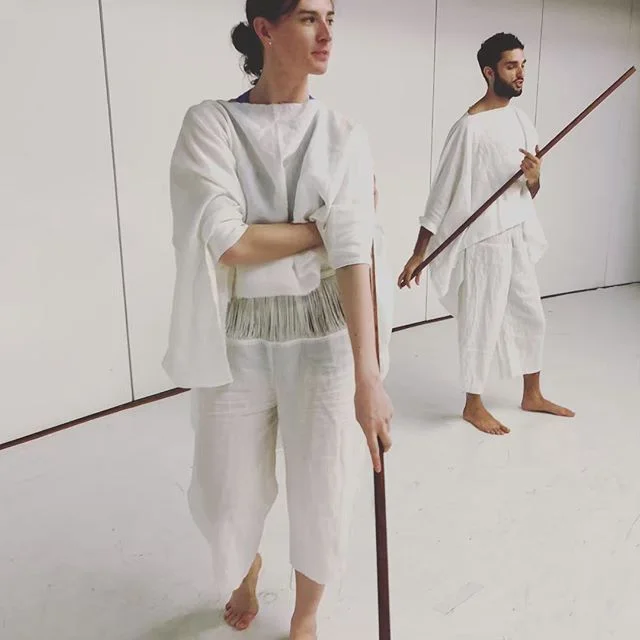All That is Gold Does Not Glitter: Pam Tanowitz at NYCB
When I saw $30 under 30 tickets available for New York City Ballet’s spring Gala performance, I decided to try for a ticket, knowing I’d be happy to have seen the new commissions from Pam Tanowitz and Justin Peck before I read about them. The $30 seats were in the fourth ring, which wasn’t a problem except that it seemed to be the seating assigned to SAB students. The prom-meets-field-trip atmosphere of the evening brought a flurry of activity—whispers during the performance, swapping seats to sit next to friends, trying to get away with sitting in seats besides their own—that would have been frustrating had I paid full price for a seat.
Both new pieces featured choreographers revisiting pieces they’d worked on previously: Peck used Mark Dancigers’ “The Bright Motion” (which he had orchestrated for last evening’s premier) to choreograph for Sara Mearns as part of City Center’s 2013 Fall For Dance series, and Tanowitz worked with Béla Bartók’s String Quartet No. 5 in a 2017 residency as part of American Ballet Theater’s Women’s Movement initiative.
Justin Peck’s “Bright” © Erin Baiano
After quick remarks from Jonothan Stafford and Wendy Whelan, Justin Peck’s “Bright” was an inoffensive —albeit brief—introduction to the program. The costumes were pretty, the movement was pretty, but there was little of substance to the choreography. A few minutes in to the piece, I wondered if it would be a reminder of “Principa”—lovely, yes, but also easy to nod off to—and, with a cast of only six dancers, if it could come together as “Principa” does with its redeeming finale. Thankfully, the piece’s length kept the work engaging, as did the subdued rainbow of the costumes (evocative of the way the costumes for “Pictures at an Exhibition” draw the eye to new pairings of dancers).
Pam Tanowitz’s “Bartók Ballet” © Erin Baiano
Pam Tanowitz’s new work, “Bartók Ballet,” was more divisive, based off of comments overheard both during the ballet (!) and during intermission. It was challenging, no doubt, but I was thoroughly intrigued by its uncanny formations, use of the stage space, androgynous costuming, and unfamiliar opposition of the arms and lower body. Familiarizing myself with the music before attending the performance made it much easier to hone in on the choreography—I owe thanks to the unknown-to-me Spotify user “Mayrea,” who has playlists for City Ballet works of all varieties (Balanchine, Robbins, Martins, Wheeldon, etc.) and updates them with new ballets as the music is announced. Whoever you are, your playlists are so appreciated!
A New York Times profile of Tanowitz, published the day before the premier, included a heartening tidbit: “Bartók Ballet” does not represent Tanowitz’s first employment by the company. She worked at the Patron’s Lounge just out of college, pouring coffee to high level members during intermission. Allusions to history—hers, the building’s, the company’s—surfaced throughout the work: a brief duet calls to mind “Four Temperaments,” and omnipresent tight fifth positions further evoke Balanchine’s legacy; interaction with all facets of the stage space (Miriam Miller does a marvelous penchée on the proscenium, a scrim at the back of the stage provides a glimpse of a perhaps-more-private world backstage, and dancers move with parts of their bodies concealed by the wings) and Reid & Harriet’s costumes (their second of the program) ground the work in the physical space of State Theater; and the gradual transition from muted black and gold unitards, evocative of the light refracting from the multifaceted orb of the theater’s ceiling—particularly visible from the fourth ring—to solid gold leotards directly referencing the stage itself functions as a poignant reminder of Tanowitz’s journey to the present moment.
Tanowitz brings such innovation that isolating the singular innovative element is practically impossible. Men and women dance the same steps, wear the same costumes, and share partnering responsibilities equally. A slowed mazurka haunts the ballet’s final moments. The women wear pointe shoes, yet they function as a percussive elements rather than differentiators between male and female choreography. The work felt fully modern, and unlike anything I’ve seen at City Ballet. It is a challenge to decipher, and will remain one, I’m sure. But I have no doubt “Bartók Ballet” is a piece that will reward multiple viewings, growing richer as the dancers gain experience in the piece, and ultimately cementing a legacy as gilded as its costuming in NYCB’s history.
Balanchine’s “Tschaikovsky Suite No. 3” closed out the evening. Tess Reichlen and Adrian Danchig-Waring approached the “Elegie” with such concentrated romanticism that I nearly forgot I was watching the same woman who’d brought to life roles like “Rubies’” Tall Girl and “Prodigal Son’s” Siren, and I felt a new desire to see Ashley Laracey again in “Liebeslieder Waltzer” after watching her performance with Jared Angle in the second movement. Megan Fairchild has come back marvelously from her maternity leave, though the bumps in her performance of “Theme & Variations” were emphasized by Gonzalo Garcia’s performance, making me miss Joaquin de Luz’s bravado and finesse.
Tanowitz already has another work at New York City Ballet in process for this fall: she added “Bartók Ballet” for the spring after another choreographer pulled out in February. With any luck, as audiences gain experience with Tanowitz’s work, they will not only grasp her alchemic work, but recognize it as a harbinger of what is to come at City Ballet.




